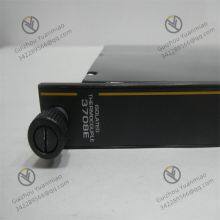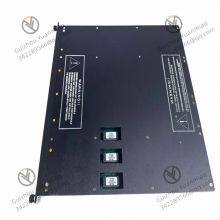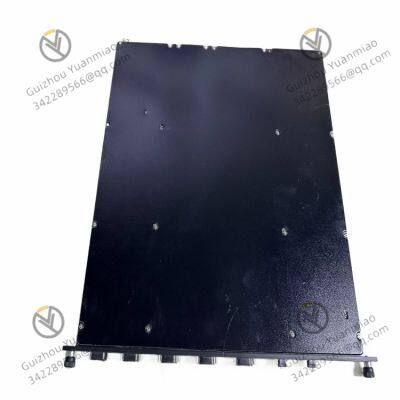TRICONEX 3708E Isolated Thermocouple Analog Input Module

The TRICONEX 3708E is an isolated thermocouple analog input module designed for the Triconex Trident Safety Instrumented System (SIS). Its primary function is to convert analog signals from thermocouples into digital signals and transmit them to the control system, enabling temperature measurement and other related functions. The detailed introduction is as follows:
Main Parameters:
Number of Channels: 16 channels.
Input Type: Thermocouple.
Supported Thermocouple Types: J, K, T, E, C, R, S, B.
Input Range: -200°C to +1800°C.
Accuracy: ±0.1% of full scale.
Response Time: ≤2ms.
Power Consumption: ≤5W.
Dimensions: 160mm x 100mm x 25mm.
Installation Method: DIN rail mounting.
Functional Features:
High-Precision Measurement: Utilizes a position analog-to-digital converter with an accuracy of ±0.1% of full scale, enabling precise temperature measurement.
High Reliability: Incorporates a Triple Modular Redundancy (TMR) architecture, with each channel featuring redundant design. Even if some channels fail, the module can still operate normally, meeting the requirements of SIL 3 safety level.
Fast Response: With a short response time of ≤2ms, it can meet the needs of various rapid control applications.
Strong Anti-Interference Capability: Equipped with isolation functionality to effectively prevent signal interference. Its minimum common-mode rejection ratio is -90dB at 0-60Hz, and the minimum noise rejection ratio is -100dB at DC.
Cold Junction Compensation and Linearization: Each input channel can receive variable voltage signals, perform thermocouple linearization and cold junction compensation, convert the results into Celsius or Fahrenheit, and then transmit a 16-bit signed integer representing the temperature to the main processor.
User-Friendly: Supports plug-and-play, requiring no complex configuration, facilitating installation and replacement. It also features a hot standby function, allowing online replacement of faulty modules.

Working Principle1. Signal Acquisition and Isolation
Thermocouple Signal Access:
Thermocouples reflect temperature by measuring the thermoelectric potential (Seebeck effect) of two different metal conductors. The 3708E module supports various types of thermocouples (such as K, J, T, E, R, S), and each channel can be independently configured with the thermocouple type to adapt to different temperature measurement ranges (e.g., K-type thermocouples cover -200°C to 1372°C).
Electrical Isolation Design:
The module adopts a dual isolation mechanism of inter-channel isolation and system isolation:
Each input channel is electrically isolated from other channels, internal circuits of the module, and external systems through isolation transformers or optocouplers (with an isolation voltage typically reaching 2500V AC), avoiding interference between different channels, ground loops, or fault propagation.
The isolation design also meets safety standard requirements, preventing dangerous voltages or currents from entering the safety control system and ensuring the safety of the module and backend equipment.
2. Signal Conditioning and Amplification
Amplification of Weak Signals:
The thermoelectric potential output by thermocouples is usually at the millivolt (mV) level and is susceptible to electromagnetic interference (such as noise from motors and frequency converters). The module has a built-in high-precision instrumentation amplifier that amplifies weak signals to the volt (V) level. Meanwhile, it suppresses high-frequency interference through filter circuits (such as low-pass filters) to ensure signal stability.
Cold Junction Compensation:
Thermocouple measurement is based on the temperature difference between the "hot junction (temperature measurement point)" and the "cold junction (wiring terminal)". Changes in the cold junction temperature can cause measurement errors. The 3708E module has a built-in precision temperature sensor (such as Pt1000) that real-time detects the ambient temperature of the cold junction and automatically compensates for changes in the cold junction temperature through hardware or software algorithms, ensuring the accuracy of the final temperature measurement (the compensation accuracy typically reaches ±0.5°C).

3. A/D Conversion and Digital Processing
Analog-to-Digital (A/D) Conversion:
The conditioned analog voltage signal is sent to a high-precision A/D converter (usually 16-bit or higher resolution) to convert the analog quantity into a digital signal. The module uses synchronous sampling technology to ensure that multi-channel signals are collected at the same time, avoiding measurement deviations caused by sampling time differences (especially applicable to scenarios where temperature comparison of multiple measurement points is required).
Data Verification and Fault Tolerance:
The converted digital signals undergo verification mechanisms (such as CRC verification, range verification) to eliminate abnormal values (such as signals exceeding the thermocouple range). At the same time, combined with the triple modular redundancy design of the TRICONEX system, the module data is compared for consistency with other redundant channels, and the reliability of the output data is ensured through a voting mechanism (2oo3), avoiding errors caused by single-point faults.
4. Communication with Safety Control System
Internal Data Transmission:
The processed temperature data is transmitted to the main controller (such as the TRICONEX 3700 series CPU) through the internal bus of the module (such as the dedicated backplane bus of the Tricon system), serving as input parameters for safety logic operations (for example, triggering emergency shutdown logic when the temperature exceeds the threshold).
Diagnostic Information Feedback:
The module real-time monitors its own working status (such as power supply voltage, A/D converter faults, thermocouple disconnection/short circuit) and uploads diagnostic information to the control system, supporting online fault location and alarm (such as displaying "Channel 1 thermocouple disconnection" through HMI), which meets the requirements of the SIL 3 safety standard for fault self-diagnosis.
Summary
The TRICONEX 3708E module converts the temperature difference signal of the thermocouple into reliable digital temperature data for the safety control system through four core links: isolation protection, signal conditioning, precise conversion, and redundant verification. It also has strong anti-interference ability and fault self-diagnosis capability, ensuring safe and reliable temperature monitoring in high-risk fields such as petroleum, chemical industry, and nuclear power, and providing key data support for process safety interlocking.

Application FieldsOil and Gas Industry
Extraction and Gathering Links: Used to monitor temperature parameters of drilling platforms, oil pipelines, separators, and other equipment. For example, in the process of crude oil extraction, by collecting temperature signals of wellhead devices and heating furnaces, it ensures that the equipment operates within a safe temperature range, avoiding risks such as leakage and explosion caused by overheating.
Refining Process: In key equipment such as distillation towers, reactors, and heat exchangers, real-time monitoring of material reaction temperatures provides data support for safety interlocking systems (such as ESD emergency shutdown systems), ensuring the stability and safety of the refining process.
Chemical and Pharmaceutical Industry
Chemical Reaction Process: In chemical synthesis, pharmaceutical fermentation, and other processes, thermocouple signals directly reflect the temperature changes in the reaction kettle. The 3708E module collects these signals with high precision to ensure that the reaction temperature is controlled within the process requirements, avoiding reaction out of control, unqualified products, or safety accidents caused by abnormal temperatures.
Hazardous Material Storage: Used to monitor the ambient temperature and material temperature in storage tanks, warehouses, and other areas. In conjunction with fire and gas monitoring systems (F&G), it timely warns of high-temperature hazards, preventing flammable and explosive chemicals from causing fires or explosions due to excessive temperatures.
Power Industry
Thermal Power Generation: In equipment such as boilers, steam turbines, and superheaters, collect temperature signals of high-temperature flue gas, steam, and metal walls to real-time monitor the operating status of the equipment. For example, excessive temperature of boiler tube walls may lead to tube bursting, and the high-precision measurement of the 3708E module can provide early warning to ensure the safe and stable operation of the generator set.
Nuclear Power Auxiliary Systems: In non-nuclear safety loops of nuclear power plants (such as cooling systems and pump equipment), used to monitor temperature parameters of pipelines and containers, meeting the strict requirements of the nuclear power industry for equipment reliability and safety (such as 10CFR50 and other standards).

Metallurgy and Steel Industry
Smelting Process: In equipment such as blast furnaces, converters, and rolling mills, collect temperature signals of furnace chambers, molten steel, and rolls, providing key data for smelting process control. For example, the accurate monitoring of steel plate temperature during rolling directly affects product quality, and the anti-interference ability of the 3708E module can ensure measurement stability in high-temperature and strong electromagnetic environments.
Heat Treatment Process: In annealing furnaces, quenching equipment, real-time monitoring of material temperature changes to ensure that heat treatment process parameters meet standards, and preventing equipment damage due to overheating through safety interlocking logic.
Energy and Power Industry
Gas Turbines and Steam Turbines: Used to monitor temperatures of key parts such as combustion chambers, blades, and exhaust systems of the units, avoiding equipment failures caused by local overheating, and ensuring the continuous operation of power generation or driving equipment.
Solar Thermal Power Generation: In concentrating solar power systems, monitor the temperature of heat absorbers and heat transfer fluids, ensuring the efficiency of photothermal conversion while preventing damage to equipment due to overheating.
Other Industrial Safety Fields
Aerospace Ground Test Facilities: In engine test benches, high-temperature simulation chambers, and other scenarios, collect thermocouple signals in extreme temperature environments to provide data support for test safety control.
Large Industrial Furnaces: Such as glass kilns, cement rotary kilns, monitor the temperature distribution in the furnace chamber to ensure stable production processes, and prevent furnace damage or fire risks through temperature abnormality early warning.
 Working Principle1. Signal Acquisition and Isolation2. Signal Conditioning and Amplification
Working Principle1. Signal Acquisition and Isolation2. Signal Conditioning and Amplification 3. A/D Conversion and Digital Processing4. Communication with Safety Control System
3. A/D Conversion and Digital Processing4. Communication with Safety Control System Metallurgy and Steel IndustryEnergy and Power IndustryOther Industrial Safety Fields
Metallurgy and Steel IndustryEnergy and Power IndustryOther Industrial Safety Fields












































